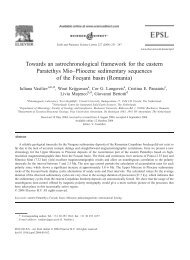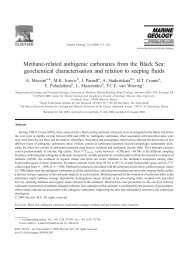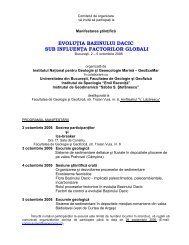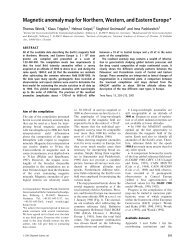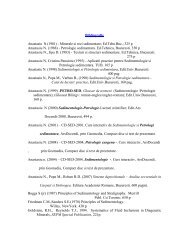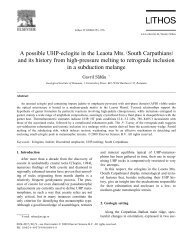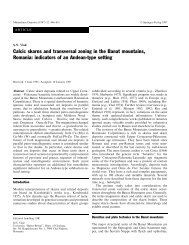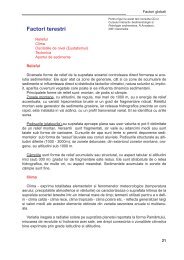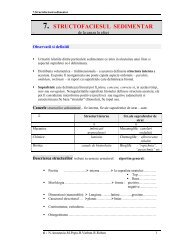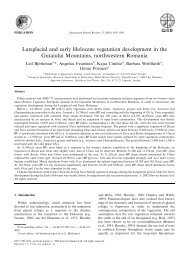The Danube submarine canyon (Black Sea ... - geo.edu.ro
The Danube submarine canyon (Black Sea ... - geo.edu.ro
The Danube submarine canyon (Black Sea ... - geo.edu.ro
You also want an ePaper? Increase the reach of your titles
YUMPU automatically turns print PDFs into web optimized ePapers that Google loves.
260<br />
I. Popescu et al. / Marine Geology 206 (2004) 249–265<br />
Fig. 8. Example of fluvial buried channels on the continental shelf (part of 3.5 kHz seismic reflection p<strong>ro</strong>file L/81, location in Fig. 2). <st<strong>ro</strong>ng>The</st<strong>ro</strong>ng><br />
asymmetrical pattern of the fill is most likely the result of lateral accretion and p<strong>ro</strong>gressive infilling of a meandering river.<br />
Nevertheless, as observed by Wong et al. (1994),<br />
the <st<strong>ro</strong>ng>Danube</st<strong>ro</strong>ng> Canyon is situated along the p<strong>ro</strong>longation<br />
of the Peceneaga-Camena fault that is a major crustal<br />
fault at the contact between the North Dob<strong>ro</strong>gea<br />
O<strong>ro</strong>gen and the Moesian Platform (Fig. 7). This fault<br />
is supposed to have played a major <strong>ro</strong>le in the<br />
evolution of the Western <st<strong>ro</strong>ng>Black</st<strong>ro</strong>ng> <st<strong>ro</strong>ng>Sea</st<strong>ro</strong>ng> basin (Banks<br />
and Robinson, 1997) and corresponds to the southeastern<br />
extremity of the Tornquist–Teisseyre Line that<br />
separates the stable Fennoscandian–East Eu<strong>ro</strong>pean<br />
craton and the fragmented West Eu<strong>ro</strong>pean Platform<br />
(Hippolyte, 2002). <st<strong>ro</strong>ng>The</st<strong>ro</strong>ng> fault outc<strong>ro</strong>ps on land but is<br />
buried offshore by thick sedimentary series since the<br />
upper Paleogene (Ionescu et al., 2002). <st<strong>ro</strong>ng>The</st<strong>ro</strong>ng> location<br />
of the fault on the outer shelf is poorly defined, still<br />
some authors have p<strong>ro</strong>posed a trajectory that follows<br />
the <st<strong>ro</strong>ng>Danube</st<strong>ro</strong>ng> Canyon (Winguth et al., 2000; Dinu et al.,<br />
2002; Fig. 7).<br />
Although it is currently uncertain if the Peceneaga–Camena<br />
fault is indeed located under the<br />
<st<strong>ro</strong>ng>Danube</st<strong>ro</strong>ng> Canyon so it could have influenced its<br />
development by creating instability on a preferential<br />
direction, this possibility cannot be excluded.<br />
4.3. Gas-related instability<br />
<st<strong>ro</strong>ng>The</st<strong>ro</strong>ng> shelfedge of the north-western margin of the<br />
<st<strong>ro</strong>ng>Black</st<strong>ro</strong>ng> <st<strong>ro</strong>ng>Sea</st<strong>ro</strong>ng> contains evidence of abundant shallow<br />
gas and represents a zone of high fluid discharge<br />
(Vassilev and Dimit<strong>ro</strong>v, 2000). Nume<strong>ro</strong>us gas seeps<br />
have been identified in this area (Ego<strong>ro</strong>v et al.,<br />
1998; Fig. 10). Most of them are located inside<br />
Fig. 9. Wave-cut terrace evidenced on the outer shelf (part of 3.5 kHz seismic reflection p<strong>ro</strong>file 3/83, location in Fig. 2). <st<strong>ro</strong>ng>The</st<strong>ro</strong>ng> terrace truncates the<br />
low angle clinoforms of a p<strong>ro</strong>grading facies. Shallow gas partially masks the sedimentary structure.



